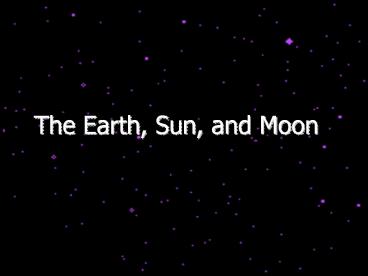The Earth, Sun, and Moon - PowerPoint PPT Presentation
1 / 20
Title:
The Earth, Sun, and Moon
Description:
As the Earth revolves, the Sun is projected in front of different constellations ... The path the Sun takes across heavens is called the ecliptic. ... – PowerPoint PPT presentation
Number of Views:1682
Avg rating:3.0/5.0
Title: The Earth, Sun, and Moon
1
The Earth, Sun, and Moon
2
Diurnal Motion
- Geocentrially speaking, the Earth sits inside a
celestial sphere. Fixed on the sphere are stars.
- Each day, the Earth rotates once (west-to-east)
on its axis. This causes us to face different
directions and see different stars. The stars
daily (diurnal) motion reflects the Earths spin.
3
The Yearly Motion
In addition to rotating, the Earth also revolves
about the Sun.
As the Earth revolves, the Sun is projected in
front of different constellations at different
times of year. The path the Sun takes across
heavens is called the ecliptic. The
constellations which the Sun passes through are
zodiac constellations.
Because the Sun is bright, we can only see some
constellations at certain times of year.
4
The Seasons
Since the plane of the ecliptic is tilted 23.5
with respect to the celestial equator, we have
seasons.
5
The Motion of the Sun
From the Geocentric point of view, the Sun moves
from the northern part to the southern part of
the sky with the seasons.
When the Sun is furthest north (south), its the
summer (winter) solstice. When the Sun crosses
the celestial equator, its the vernal (or
autumnal) equinox.
6
The Day
Because the Earth revolves about the Sun, the
word day has two definitions.
A sidereal day is one rotation with respect to
the stars. A solar day is one rotation with
respect to the Sun. Sidereal and solar days
differ by about 4 minutes.
7
Precession
In addition to its rotation and revolution, the
Earths axis also precesses (wobbles) like a top.
The angle between the ecliptic and the equator
remains at 23.5, but the direction changes. The
period of this precession of the equinoxes is
about 26,000 years.
8
Because of precession
- Polaris wont always be the North Star
- A sidereal year is not quite a Julian year.
- Orion wont always be a winter constellation
- Horoscopes are all wrong!
9
The Lunar Period
The Moon moves west-to-east in the sky (like the
Sun), and takes about a month to circle the
Earth (hence the word month). But once again,
theres a difference between the Moons sidereal
period with respect to the stars (27 days), and
the synodic period with respect to the Sun (29
days).
10
Phases of the Moon
The Moon reflects light from the Sun, so its
phase tells you the relative position of the
Sun. You can therefore tell time from the Moon!
11
Phases of the Moon
Full Moon occurs when the Moon is opposite in the
sky from the Sun. This is called
opposition. New Moon occurs when the Moon is in
the same direction as the Sun, i.e., in
conjunction.
12
The Moons Shadow
The Moons orbital plane is tilted by 5.2 from
the ecliptic plane. Hence, ½ the time, the Moon
is slightly north of the ecliptic (and ½ the
time, it is south of the ecliptic). The shadow
of one body very rarely falls on the other.
13
Lunar Eclipses
If the Moon crosses the ecliptic plane while
exactly opposite the Sun, it will fall in the
Earths shadow. This is a lunar eclipse. This
happens roughly twice a year.
14
Solar Eclipses
If the Moon crosses the ecliptic plane while
exactly in front of the Sun, a tiny piece of the
Earth will fall in the Moons shadow. This is a
solar eclipse. Since the Moon and Sun appear to
be the same size in the sky, the alignment of a
total solar eclipse must be perfect.
15
Total Solar Eclipse
You only get to see this outer atmosphere
(corona) of the Sun if the Suns entire body is
blocked out.
16
(No Transcript)
17
Partial Solar Eclipse
If youre on the edge of an eclipse path and only
a slice of the Sun is blocked out, its called a
partial eclipse. These are not very exciting,
since the uneclipsed part of the Sun is still
extremely bright.
18
Annular Eclipses
Because the Moons orbit about the Earth is not
perfectly circular, it is sometimes too far away
to block out the whole Sun, even when perfectly
aligned. When this happens, you get an annular
eclipse. It is rarer than a total solar eclipse,
but, like other partial eclipses, they are, in
general, pretty boring.
19
Solar Eclipse Paths through 2025
20
Next time -- The Problem with Planets






























